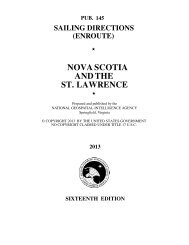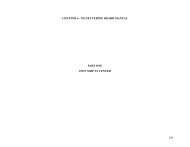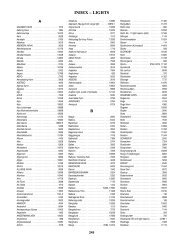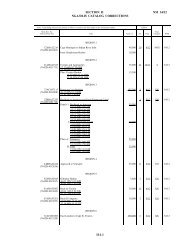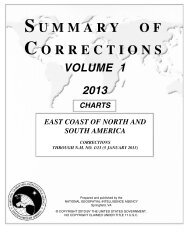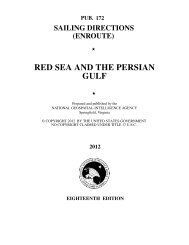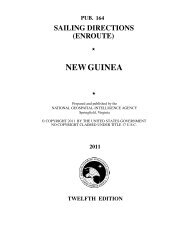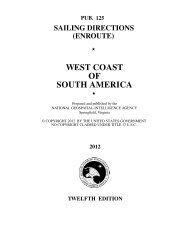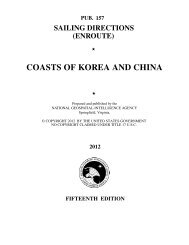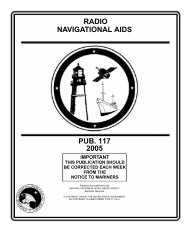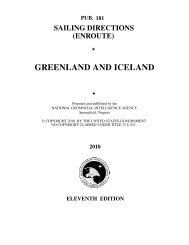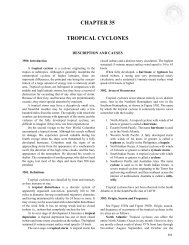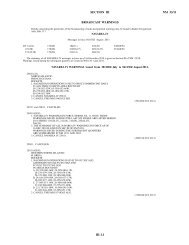LIST OF LIGHTS - Maritime Safety Information - National Geospatial ...
LIST OF LIGHTS - Maritime Safety Information - National Geospatial ...
LIST OF LIGHTS - Maritime Safety Information - National Geospatial ...
Create successful ePaper yourself
Turn your PDF publications into a flip-book with our unique Google optimized e-Paper software.
<strong>LIGHTS</strong>HIPS, SUPERBUOYS, AND <strong>OF</strong>FSHORE LIGHT STATIONS<br />
Courses should be set to pass all floating aids to navigation<br />
with sufficient clearance to avoid the possibility of<br />
collision from any cause. Experience shows that floating<br />
aids to navigation cannot be safely used as leading marks<br />
to be passed close aboard, but should always be left broad<br />
off the course, whenever searoom permits.<br />
When approaching a lightship, superbuoy, or a station<br />
on a submarine site on radio bearings, the risk of collision<br />
will be avoided by insuring that the radio bearing does not<br />
remain constant.<br />
Most lightships and large buoys are anchored with a<br />
very long scope of chain and, as a result, the radius of their<br />
swinging circle is considerable. The charted position is the<br />
location of the anchor. Furthermore, under certain conditions<br />
of wind and current, they are subject to sudden and<br />
unexpected sheers which are certain to hazard a vessel<br />
attempting to pass close aboard.<br />
During extremely heavy weather and due to their<br />
exposed locations, lightships may be carried off station.<br />
The mariner should, therefore, not implicitly rely on a<br />
lightship maintaining its precisely charted position during<br />
and immediately following severe storms. A lightship<br />
known to be off station will secure her light, fog signal,<br />
and radiobeacon and fly the International Code signal<br />
“LO” signifying “I am not in my correct position.”<br />
Danish lights are exhibited 15 minutes after sunset and<br />
extinguished 15 minutes before sunrise.<br />
Russian lights are shown throughout the winter when<br />
icebreakers are working.<br />
The latest Russian charts and publications give only sufficient<br />
details for navigation to the ports open to international<br />
trade. Thus, in this volume, only those lights along<br />
the routes to such ports can be assumed to be correct. Elsewhere<br />
the latest information, often not of very recent date,<br />
is listed.<br />
Radio navigational aids and certain lights on the Russian<br />
Arctic coast and adjacent islands north of the Arctic<br />
Circle from Novaya Zemlya east to the Bering Strait, have<br />
been omitted due to the lack of reliable information.<br />
Russian lights are shown between the parallels of:<br />
63°40'N. and 66°N. from 27 July to 15 December; south of<br />
66°N. from 5 August to 20 May; 68°N. and 70°N. from 14<br />
August to 30 April.<br />
In the White Sea west of the meridian of 38°E. they<br />
shown: north of 66°N. from 28 July to 15 December; south<br />
of 66°N. from 6 August to 15 December.<br />
In the eastern part of the White Sea between the meridians<br />
of 38°E. and 43°E. they are shown: south of 66°N.<br />
from 1 May to 31 May and from 28 July to 15 January;<br />
between 66°N. and 68°N. from 1 May to 21 May and 6<br />
August to 15 January.<br />
Lights in the Barents Sea and White Sea are extinguished<br />
as soon as the whole sea horizon is covered with<br />
XIV<br />
solid ice. The lights are re-shown as soon as open spaces<br />
are seen, or when the ice appears to begin to move; should<br />
a vessel be seen at such a time, even if the movement of<br />
the ice is arrested, the lights will not be extinguished<br />
unless the crew has abandoned the vessel and communication<br />
cannot be effected.<br />
In Iceland the elevations of lights are approximate; they<br />
may be as much as 10% in error and should not be used for<br />
fixing distances by vertical danger angle. Lights may<br />
become completely obscured by dust clouds when the<br />
wind is off the land. This is particularly true in autumn,<br />
even in clear weather.<br />
South of 65°30'N. lights are shown from 15 July to 1 June.<br />
Lights north of 65°30'N. are shown from 1 August to 15 May.<br />
In Norway, lights show sectors of different colors; the fairway<br />
is usually marked by a white sector to a ship approaching<br />
the light, a green sector to starboard and a red sector to port.<br />
The white navigational sector is usually very narrow and caution<br />
should be exercised to keep in its centerline.<br />
Dangers in or near the fairway are marked by red or<br />
green sectors and when the light has sectors of different<br />
characters they are marked by:<br />
Fl.(2) lights having a period of about 12 seconds with<br />
the duration of each flash from 1 to 1.5 seconds.<br />
Iso. lights with a period of from 1 to 2.5 seconds.<br />
Most lights in Norway are displayed seasonally based<br />
on latitude as shown in the following table:<br />
Latitude Dates of display<br />
60° 4 July - 2 June<br />
61° 9 July - 28 May<br />
62° 16 July - 21 May<br />
63° 21 July - 16 May<br />
64° 25 July - 12 May<br />
65° 29 July - 8 May<br />
66° 1 August - 5 May<br />
67° 4 August - 2 May<br />
68° 7 August - 29 April<br />
69° 10 August - 26 April<br />
70° 12 August - 24 April<br />
Where navigation channels cross the threshold latitudes,<br />
the display dates are modified to maintain consistency<br />
within the channel. Note that some navigation aids, including<br />
private aids, do no follow this schedule.<br />
Russian lightships remain on their station during the<br />
period of navigation only; when forced to leave because of<br />
ice they are replaced as soon as possible. Lightships, by<br />
day, show a ball over a yellow flag with a blue St.<br />
George’s cross and by night, a white riding light.<br />
If a vessel is seen standing into danger the signal “NF”<br />
of the International Code of Signals is hoisted, and if not<br />
immediately seen, rockets with two explosions and bright<br />
stars may be fired every minute; by night the rockets only



